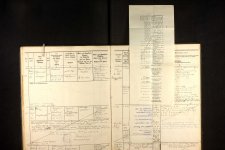Björn Bergenholtz
(former alias "Calalp")

Here´s some possibly additional info, maybe worth considering, on ...
moszkowskii as in:
• the subspecies Moszkowski's Green-winged King Parrot Alisterus chloropterus moszkowskii REICHENOW 1911 (here) as "Aprosmictus moszkowskii": ... gesammelt von Dr. M oskowski [sic].
• the invalid "Edoliisoma schisticeps moszkowskii" NEUMANN 1917 (here): "Dr. Moszkowski coll."
... which most likely commemorates Dr. Max Moszkowski (1873-1939*), from Wrocław (Breslau in German), Polish alt. Prussian or German traveler, explorer, ethnologist, anthropologist, zoologist and collector (of just about everything) ...
*Disclaimer: His death year is based only (no details found) on the following links; here, here and here (bottom p.8-10). Also see here ... and all over the internet.
He´s present in today's HBW Alive Key as:
More about this guy is found in The Eponym Dictionary of Birds 2014 (here), by Beolens et al ... this said, even if I find his alleged death above (in 1939) a bit far away to fit into their claim of "c.1950".
He´s also (for example) commemorated in the Fish Moszkowski's labeo (a Carp) Labeo moszkowskii AHL 1922 (here) and in the invalid frog "Cornufer moszkowskii" VOGT 1912 (here).
However: Enjoy!
Björn
PS. And, as always: don´t hesitate to prove otherwise!
moszkowskii as in:
• the subspecies Moszkowski's Green-winged King Parrot Alisterus chloropterus moszkowskii REICHENOW 1911 (here) as "Aprosmictus moszkowskii": ... gesammelt von Dr. M oskowski [sic].
• the invalid "Edoliisoma schisticeps moszkowskii" NEUMANN 1917 (here): "Dr. Moszkowski coll."
... which most likely commemorates Dr. Max Moszkowski (1873-1939*), from Wrocław (Breslau in German), Polish alt. Prussian or German traveler, explorer, ethnologist, anthropologist, zoologist and collector (of just about everything) ...
*Disclaimer: His death year is based only (no details found) on the following links; here, here and here (bottom p.8-10). Also see here ... and all over the internet.
He´s present in today's HBW Alive Key as:
If German or Polish depends on how you look at it, as Wrocław (Breslau) was part of Prussia and Germany all the way until the end of WWII.moszkowskii
Dr Max Moszkowski (b. 1873) German physician, anthropologist, collector in Ceylon, Sumatra and New Guinea 1907-1911 (subsp. Alisterus chloropterus, syn. Coracina schisticeps reichenowi).
More about this guy is found in The Eponym Dictionary of Birds 2014 (here), by Beolens et al ... this said, even if I find his alleged death above (in 1939) a bit far away to fit into their claim of "c.1950".
He´s also (for example) commemorated in the Fish Moszkowski's labeo (a Carp) Labeo moszkowskii AHL 1922 (here) and in the invalid frog "Cornufer moszkowskii" VOGT 1912 (here).
However: Enjoy!
Björn
PS. And, as always: don´t hesitate to prove otherwise!





